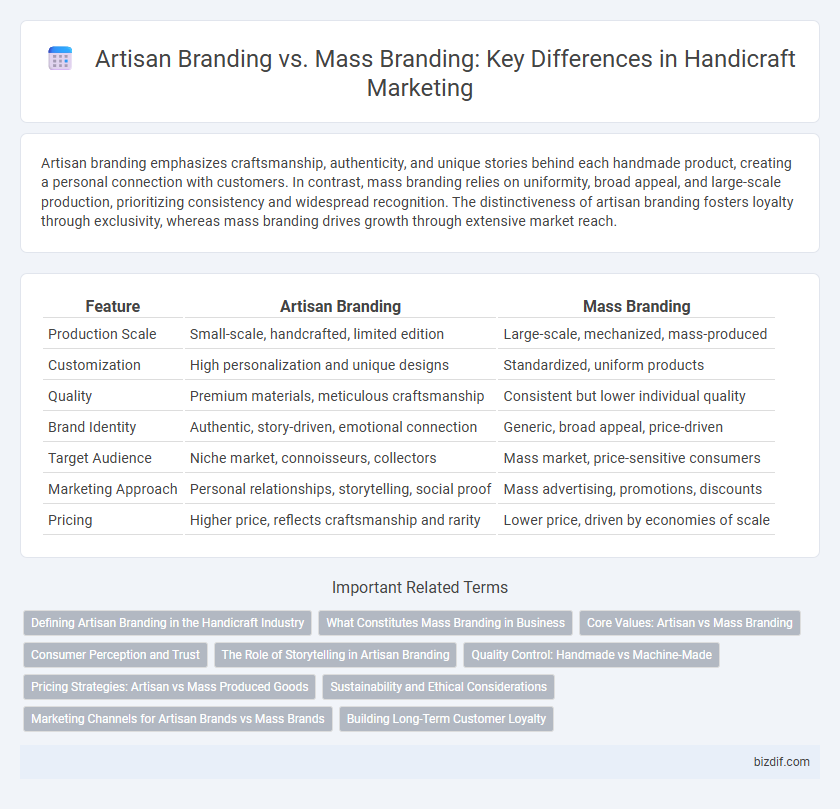Artisan branding emphasizes craftsmanship, authenticity, and unique stories behind each handmade product, creating a personal connection with customers. In contrast, mass branding relies on uniformity, broad appeal, and large-scale production, prioritizing consistency and widespread recognition. The distinctiveness of artisan branding fosters loyalty through exclusivity, whereas mass branding drives growth through extensive market reach.
Table of Comparison
| Feature | Artisan Branding | Mass Branding |
|---|---|---|
| Production Scale | Small-scale, handcrafted, limited edition | Large-scale, mechanized, mass-produced |
| Customization | High personalization and unique designs | Standardized, uniform products |
| Quality | Premium materials, meticulous craftsmanship | Consistent but lower individual quality |
| Brand Identity | Authentic, story-driven, emotional connection | Generic, broad appeal, price-driven |
| Target Audience | Niche market, connoisseurs, collectors | Mass market, price-sensitive consumers |
| Marketing Approach | Personal relationships, storytelling, social proof | Mass advertising, promotions, discounts |
| Pricing | Higher price, reflects craftsmanship and rarity | Lower price, driven by economies of scale |
Defining Artisan Branding in the Handicraft Industry
Artisan branding in the handicraft industry emphasizes unique, handmade quality, authentic storytelling, and cultural heritage, distinguishing products through individual craftsmanship and local tradition. This approach contrasts mass branding by highlighting limited production, personalized customer connections, and the artisanal creator's identity. Artisan branding leverages the narrative of skill, exclusivity, and sustainable practices to attract niche markets valuing originality and ethical consumption.
What Constitutes Mass Branding in Business
Mass branding in business involves creating widespread brand recognition through standardized products, consistent messaging, and large-scale advertising campaigns targeting broad consumer segments. It emphasizes uniformity, high-volume production, and price competitiveness, often sacrificing uniqueness and personal connection to appeal to mass markets. This approach contrasts with artisan branding, which highlights individuality, craftsmanship, and personalized narratives to attract niche audiences.
Core Values: Artisan vs Mass Branding
Artisan branding centers on authenticity, craftsmanship, and unique storytelling, reflecting core values such as tradition, quality, and personal connection. Mass branding emphasizes scalability, consistency, and broad appeal, prioritizing efficiency, uniformity, and widespread recognition. These divergent values influence consumer perception, with artisan brands fostering loyalty through exclusivity and mass brands driving market dominance through accessibility.
Consumer Perception and Trust
Artisan branding emphasizes unique craftsmanship and personal stories, fostering strong consumer trust through perceived authenticity and exclusivity. Mass branding relies on consistent messaging and widespread recognition, which builds consumer confidence through reliability and familiarity. Consumers often associate artisan brands with higher quality and integrity, while mass brands are valued for accessibility and uniformity.
The Role of Storytelling in Artisan Branding
Artisan branding leverages storytelling to convey the unique heritage, craftsmanship, and values behind each handmade product, creating an emotional connection with consumers. This narrative approach differentiates artisan brands from mass branding by emphasizing authenticity, tradition, and the individual artisan's expertise. Storytelling enhances perceived value, fostering customer loyalty and justifying premium pricing in the handicraft market.
Quality Control: Handmade vs Machine-Made
Artisan branding emphasizes meticulous quality control through handcrafted processes, ensuring each product is unique and meets high standards of craftsmanship. In contrast, mass branding relies on machine-made production lines that prioritize uniformity and scale, often sacrificing the nuanced detail found in handmade goods. The personalized inspection and skilled techniques in artisan branding create superior durability and aesthetic value compared to the standardized output of mass-produced items.
Pricing Strategies: Artisan vs Mass Produced Goods
Artisan branding leverages exclusivity and craftsmanship to justify premium pricing, emphasizing unique hand-made qualities that resonate with niche markets willing to pay higher prices. Mass branding relies on economies of scale and uniform production to offer competitive pricing, targeting broad consumer bases with cost-effective goods. Pricing strategies for artisan products prioritize value perception and limited availability, while mass-produced goods focus on volume sales and market penetration.
Sustainability and Ethical Considerations
Artisan branding emphasizes sustainable practices by promoting handmade, locally sourced materials and fair labor conditions, reducing environmental impact and supporting ethical craftsmanship. Mass branding often relies on large-scale production, which can lead to resource depletion and exploitative labor, challenging sustainability goals. Prioritizing artisan branding fosters transparent supply chains and responsible consumption aligned with ethical and environmental values.
Marketing Channels for Artisan Brands vs Mass Brands
Artisan brands primarily leverage niche marketing channels such as local markets, craft fairs, and social media platforms like Instagram and Pinterest, which emphasize storytelling and direct consumer engagement. In contrast, mass brands utilize broad-reaching channels including television, large-scale retail distribution, and digital advertising on platforms like Facebook and Google Ads to maximize audience exposure. The targeted, community-centric approach of artisan brands fosters brand loyalty, while mass brands prioritize wide market penetration through high-volume marketing strategies.
Building Long-Term Customer Loyalty
Artisan branding emphasizes unique, handcrafted qualities that foster emotional connections and trust, driving long-term customer loyalty through personalized experiences and storytelling. Mass branding relies on broad appeal and consistency, often focusing on widespread recognition rather than deep individual engagement. Sustained loyalty is stronger in artisan branding due to the perceived authenticity and exclusivity valued by discerning customers.
Artisan Branding vs Mass Branding Infographic

 bizdif.com
bizdif.com